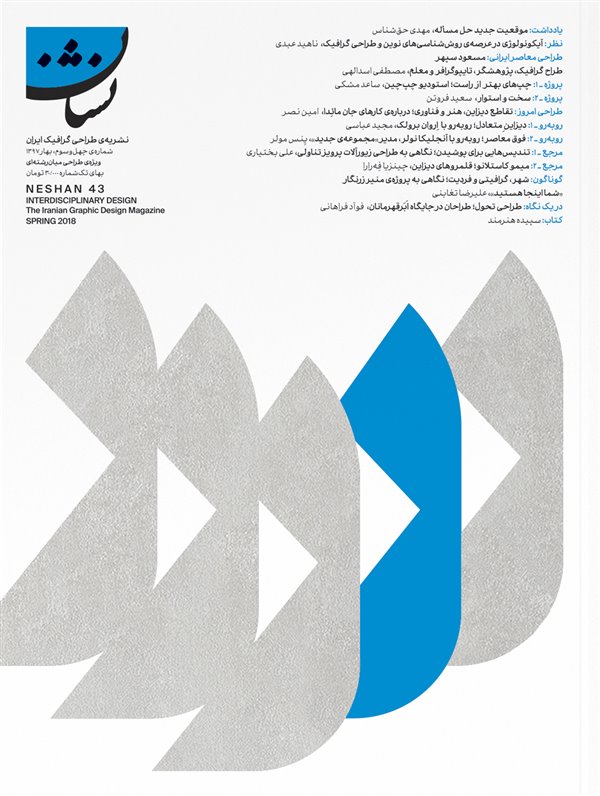Neshan 43

Opinion
Iconology Within The Domains Of Modern Methodologies And Graphic Design
Nahid Abdi
The twentieth century witnessed tremendous achievements across all fields of human knowledge. These achievements have irrefutably changed our perspective and approach to the issues and problems resulting in a change from the common paradigm of Positivism to Constructivism. This shift took place following two transitional periods of Postpositivism followed by Critical Theory. Of course, the outcome of this transition was overwhelmingly at the expense of two terrible world wars, the cause of which were underlying political and economic conflicts as well as fundamental alterations in how people think. At the core of achievements in the various fields of science and knowledge, was a key point that brought us to the realization that humans are multidimensional beings that can not be understood and addressed by a common quantitative approach. In other words, these phenomena have qualitative characteristics. Today this principle has not only been generalized in the field of human sciences, but has transformed the ontology, epistemology, and methodology across all fields of human knowledge. As a result, the way has been paved for inter-methodological and interdisciplinary sciences, as well as multidisciplinary and transdisciplinary subjects. Many artists and designers can be readily named as theorists in terms of changing the approach to their goals and practices.
 Paula Scher, Poster for the Public Theater, 1995
Paula Scher, Poster for the Public Theater, 1995
Nevertheless, there has always been an attempt to theorize among artists, architects and designers; Zaha Hadid, for example, a contemporary architect who considered herself a theorist. In the field of graphic design, some designers are known as theorists of this discipline, such as Aleksandr Rodchenko and El Lissitzky, the pioneers of Constructivism. Others, like Saul Bass, Paul Rand, Paula Scher, Neville Brody among others, focused on interdisciplinary approaches to graphic design. Many of these artist/designers have published their thoughts on the relationship between theory and practice in articles, essays, journals, and online publications.
In the field of art history, the Warburg Circle is considered as one of the pioneers and protagonists of this shift in attitude towards artistic subjects. The study of the mural painting of the Palazzo Schifanoia in 1912 by Aby Warburg indicated that the art of a particular period of time can be connected with religion, philosophy, literature, science, politics and the social fabric of the very same period to various degrees. In other words, the outbreak of qualitative-comparative methods is obtained from his study. Moreover, Warburg also made it clear that there is a fundamental relationship between classical antiquity and the medieval period and the modern era in many respects, thus acknowledging that the works of various art and design disciplines can be considered valuable historical documents. The significance of this point lies in its comprehensiveness, i.e. it contains a wide spectrum of works ranging from ancient instruments and works of art to contemporary applied design. Although there was no discussion of qualitative methods and modern disciplines at the time, the scholars’ studies on the Warburg Circle has challenged the traditional boundaries of art history opening the way to a new era of theoretical studies in art. These studies resulted in a standardization and introduction of the methodology and the theory known as Iconology. Though this theory was the result of the Warburg Circle’s collective effort, it was further developed and given greater expression by Erwin Panofsky.
In 1932, Panofsky first introduced the concept in an introductory edition and later in the introduction of his famous book “Studies in Iconology (Humanistic Themes in the Art of Renaissance)”. The significance of Panofsky’s introduction, which strengthened the theoretical aspect of this method, lies in his focus on explaining the keywords and defining/differentiating the basic concepts which he later used in his criteria development of the “method” as a “tool” in the next step. Further, other key principles and concepts of the iconology methodology have emerged through the body of his study. Panofsky has discussed three key concepts of “form”, “image”, and “subject matter or meaning” and started off by defining them. Although he highlights the pivotal role of the meaning, he never considers it as the main principle. Hence, he defines three semantic layers: “primary, secondary, and intrinsic meaning” and in his strategy, he orders the criteria of iconology into three stages, including: “iconographic description”, “iconographic analysis”, and “iconographic interpretation or iconology”. His strategy encompases the transition from the history of thought, and in particular, moving from form to image, and ultimately gaining access to the intrinsic meaning in the triple process of “Recognition”, “Analysis” and “Synthesis”.
The iconographic description is reveals intrinsic meaning by identifying forms and their relationships through practical experience. This is enhanced by familiarization with images, their respective subjects, with an emphasis on the history of the style. The second stage of iconographic analysis is devoted to the identification and understanding of the meanings and expressional connotations by referencing all possible literary sources or focusing on the history of types. To bring the topic to light, the goal is familiarity with specific themes and concepts of art at this stage.
It is worth noting that the major focus of iconology occurs at this stage: identifying and understanding the implied implications of a work of art has a great deal of meaning. Consequently, the main purpose of this process is to compile the meanings and potential meanings (both conscious and subconscious)the artist has intended and are hence depicted inthe work of art. At this stage, one of the important features of the qualitative methodology—found in the infrastructure of all interdisciplinary and multidisciplinary issues—are the characteristics of Pluralism, Critical Approach, Dialogue with the Subject, Polyphonic, and a Focus on content. Hence, identifying these points beyond the artwork underscores enrichment and extension of meaning. Looking at the history of art, it is possible to find legendary works that are intertwined with this principle. In a comparative approach, the latter is akin to the “Art of Ambiguity” in Persian literature. In the final stage, the iconographic interpretation focuses on access to intrinsic meaning through an understanding of the symbolic values in thehistory of cultural signs and symbols, and the synthesis of all human principles into a single level. This stage depends on the ability of the researcher to suggest synthetic intuition in understanding the basic tendencies of the human mind, which is conditioned by individual psychology and interpretative hindsight.
From a methodological point of view, therefore, iconology is “comparative” in principle and promises explicitly interdisciplinary and multidisciplinary issues. The critique of the interpreter from is also embeded within this method. This is because iconology resists the generalization of sensory and personal responses of the audience or interpreter, instead emphasizing the immediate and personal contributions of the audience. In fact, scholars in the early twentieth century—and consequently the Warburg Circle, as well as Panofsky—were not in pursuit of a methodology in the modern sense. Rather, they sought a spark that would change the paradigm,thusmodern methodology has its roots in their study. Their theoretical-methodological values in the last decades of the twentieth century—when the question of methodology and method became a major issue in all sciences—has been refined and analyzed by contemporary thinkers beyond their works. Therefore, iconology is nowadays recognized and validated not only as a useful tool in the study of artistic works but also at the level of a theory and human knowledge. Although it was initially used to study Christian art, it also has seen great success in the analysis of modern and abstract art.
As a consequence, it has been efficient tool in the analysis of a variety of arts such as music, cinema, architecture, graphic design, handicrafts, and manuscripts. It’s use has also grown to include interpretation of Banksy’s graffiti work on the bridge wall in Hull, a film title design by Saul Bass, and in recognition and interpretation of Dmitri Shostakovich’s musical compositions.
The outstanding posters of Paula Scher for The Public Theater, for instance, is a fabulous formation of layered meaning in a piece of graphic design. In the very first layer, words and the image of a man act as the key components which form the factual meaning meaning of the poster, i.e. something related to the public theater. On the other hand, the separation and differentiation of words in regards to the font size, alignment in different directions, distinct use of black and red color on a yellow background, and the composition and pose all neatly contribute to an expressional meaning of the artwork that conveys the sense of a busy, crowded place that can be simultaneously be amusing and unpredictable. In this way, the first layer of meaning that is the subject of the poster is identified. But in order to fully understand the content, theme, and stories which are carried through the textual expressions on the poster, one would need to refer to texts and pretexts – e.g. theater and New York City – to figure out the implications and connotations hidden in each of those expressions. This is how the study and understanding of implications, stories, and allegories that are transferred to the audience through a combination of text and image, form the second layer of meaning. Moreover, one could not simply figure out the hidden meaning of the design unless one has a comprehensive knowledge of symbols and cultural signs relevant to the poster has along with a familiarity of the designer’s work and personal background. Thus, achieving a thorough understanding of the content and meaning of layers is rather arduous and conditional. This might go without saying that artworks in different fields of design are multilayered and multidimensional, hence a comprehensive understanding of them would be out-of-reach if one doesn’t possess vast and deep knowledge, precision of thought, strong reasoning, infinite patience, and above all the flexibility to control personal and intuitive perceptions. These are all principles on which modern methods and fields are established and taken into consideration with today’s comparative methods.
New Situation For Problem Solving
Mehdi Haghshenas
> more
Iranian Contemporary Design
Masood Sepehr; Graphic Designer, Researcher, Typographer And Teacher
Mostafa Assadollahi
> more
Project-I
Lefts Better Than Rights! ChapChinStudio
Saed Meshki
> more
Project-II
Tough And Firm
Saeid Forootan
> more
Design Today
John Maeda; The Intersection Of Design, Art, And Technology
Amin Nasr
> more
Face To Face-II
Face To Face With Erwan Bouroullec; The Well-Balanced Design
Majid Abbasi
> more
Face To Face-II
Face To Face With Angelika Nollert; Super Contemporary
Jens Mueller
> more
Reference-I
Sculptures To Wear; A Review Of Ornaments Designed By Parviz Tanavoli
Ali Bakhtiari
> more
Reference-II
Mimmo Castellano; The Territories Of The Project
Cinzia Ferrara
> more
Different
City, Graffiti And Individuality; “You Are Here” A Project By Monir Zarnegar
Alireza Taghaboni
> more
Overview
Transformation Design; Designers As Superheroes
Foad Farahani
> more